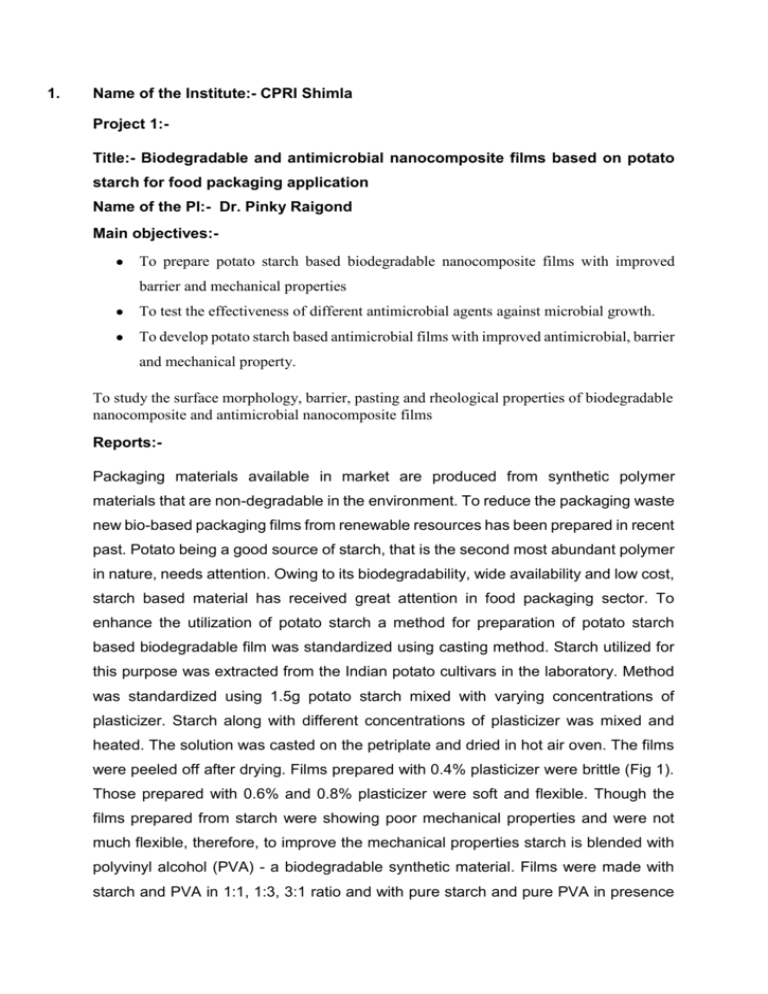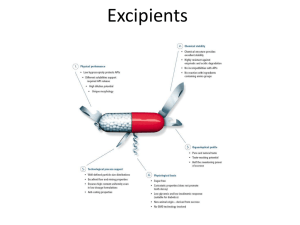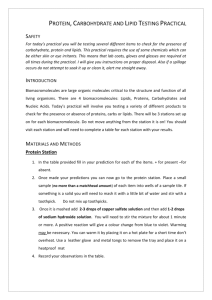CPRI Shimla
advertisement

1. Name of the Institute:- CPRI Shimla Project 1:Title:- Biodegradable and antimicrobial nanocomposite films based on potato starch for food packaging application Name of the PI:- Dr. Pinky Raigond Main objectives: To prepare potato starch based biodegradable nanocomposite films with improved barrier and mechanical properties To test the effectiveness of different antimicrobial agents against microbial growth. To develop potato starch based antimicrobial films with improved antimicrobial, barrier and mechanical property. To study the surface morphology, barrier, pasting and rheological properties of biodegradable nanocomposite and antimicrobial nanocomposite films Reports:Packaging materials available in market are produced from synthetic polymer materials that are non-degradable in the environment. To reduce the packaging waste new bio-based packaging films from renewable resources has been prepared in recent past. Potato being a good source of starch, that is the second most abundant polymer in nature, needs attention. Owing to its biodegradability, wide availability and low cost, starch based material has received great attention in food packaging sector. To enhance the utilization of potato starch a method for preparation of potato starch based biodegradable film was standardized using casting method. Starch utilized for this purpose was extracted from the Indian potato cultivars in the laboratory. Method was standardized using 1.5g potato starch mixed with varying concentrations of plasticizer. Starch along with different concentrations of plasticizer was mixed and heated. The solution was casted on the petriplate and dried in hot air oven. The films were peeled off after drying. Films prepared with 0.4% plasticizer were brittle (Fig 1). Those prepared with 0.6% and 0.8% plasticizer were soft and flexible. Though the films prepared from starch were showing poor mechanical properties and were not much flexible, therefore, to improve the mechanical properties starch is blended with polyvinyl alcohol (PVA) - a biodegradable synthetic material. Films were made with starch and PVA in 1:1, 1:3, 3:1 ratio and with pure starch and pure PVA in presence of 0.6% plasticizer (Fig 2). Films prepared with pure starch lack flexibility and clarity and were brittle. Flexibility improved with increasing the concentration of plasticizer. Films made of PVA were more flexible, soft and transparent than films made of pure starch and different ratios of starch and PVA. Starch and PVA in 1:3 ratio showed good results, with soft, flexible and semi-transparent films. Once the properties of starch based films are improved, it can be a good replacement for plastic based packaging and can be used as biodegradable packaging material. B A C Fig. 1. Starch films made of (A) 0.4%, (B) 0.6% and (C) 0.8% plasticizer A C B D E Fig.2. Films made of (A) PVA, (B) Starch, (C) Starch: PVA 1:3 (D) 3:1 (E) 1:1 ratios Degradation of starch film in soil Methodology for preparation of cellulose nanowhiskers The films made by starch are gaining importance since it is eco-friendly and expected to be widely acceptable by the society. Potato starch based films with addition strength by addition of cellulose nanowhiskers can be prepared. Cellulose is the most abundant polymer in nature and has great potential in its nanoform (nanowhiskers) due to its role in large number of applications. Cellulose nanowhiskers or nanofibres are defined as crystalline rod-like nanoparticles with diameter of 2-20nm and length of 100nm to 2.1 µm and are obtained by acid hydrolysis of cellulose fibers. Cellulose nanowhiskers were prepared with the aim to utilize them for formation of nanocomposite biodegradable films to enhance the mechanical strength and barrier properties of potato starch based biodegradable films. Method for preparation of cellulose nanowhiskers was optimized by ‘Top Down’ approach of nanotechnology. To prepare cellulose nanowhiskers, cellulose microcrystalline was hydrolyzed. The sample was diluted with distilled water and centrifuged repeatedly, until a stable pH of 7.0 reached. Cellulose nanowhiskers had a white gel appearance as shown in Figure (3B). Washed sample with stable pH was examined under Transmission Electron Microscope (TEM) for its dimensions. The TEM images revealed that the aqueous suspension of cellulose nanowhiskerswere rod like nanoparticles, agglomerated in the forms of bundles while some of them were single i.e., well separated and in bundles as well and the size was ranging between 4-20 x 110-250 nm (Fig. 3C). The above methodology can be adopted to generate cellulose nanowhiskers for its further use in respective areas. 0.8µm A B C 6.2nm 200nm 4.2µm Fig:3 Images of cellulose microcrystalline (A), dilute suspension of cellulose nanowhiskers (B) and TEM image of cellulose whisker (C). Project 2:Title:- Nanoparticles for detection and intra-cellular localization of Potato pathogens. Name of the PI:- Dr. Baswaraj Raigond Main objectives: Standardization of protocols for detection of potato pathogens (PVX, PVS, PLRV, Phytophthora infestans and Ralstonia solanacarum) using nanoparticles of different emission wavelengths. Protocol development for in situ detection of potato pathogens in micropropagated tissue by Confocal Lazer Scanning Microscopy and TEM. Report: i) A study was initiated to detect Potato virus A (PVA) in infected potato plants by immuno-gold electron microscope. PVA particles were completely purified and the IgG of PVA was also purifies and conjugated with colloidal gold nano particles. The IgG conjugated gold nano particles were allowed to incubate with partially purified PVA infected sap and examined under TEM which showed a good concentration of filamentous flexuous long particle coupled with several colloidal gold (CG) nano particles revealing the presence of PVA. More than one IgG-CG complex was associated with each PVA particle indicating its successful conjugation with gold particles. Since only the homologous virus will be decorated with IgG-CG complex, it can be used for specific detection and diagnosing a targeted virus even in mixed infection of viruses with similar morphology. A B IgG-CG PVA ii) GLAD-Potato virus M (PVM): A study was initiated to detect Potato virus M (PVM) in infected potato leaves by immune-gold electron microscopy. Purified IgG of PVM was conjugated with Gold nanoparticles for electron microscopic detection of PVM. The IgG conjugated with gold nanoparticles were incubated with the suspected potato leaf samples and processed for electron microscopic examination which showed a good concentration of filamentous flexuous long particle coupled with several colloidal gold (CG) nano particles revealing the presence of PVM. More than one IgG-CG complex was associated with each PVM particle indicating its successful conjugation with gold particles. Since only the homologous virus will be decorated with IgG-CG complex, it can be used for specific detection and diagnosing a targeted virus even in mixed infection of viruses with similar morphology. Thus this technique can be used successfully for detection or screening of PVM in potato plant samples. C B A IgG-CG PVM Fig: Typical spoon-shaped symptoms of PVM in potato (A), detection of PVM by IgG-CG complex (B) and coupling of more than one IgG-CG complex with PVM (C). iii) Involved in: Protocol for synthesis of cellulose nanowhiskers and starch nanocrystals 0.8µm 4.2µm A B 6.2nm C 200nm Fig 1: Images of cellulose microcrystalline (A), dilute suspension of cellulose nanowhiskers (B) and TEM image of cellulose whisker (C). Project 3:Title:- Development of lateral flow assay Kits for the detection of potato pathogens. Name of PI:- Dr. A. Jeevalatha Main objectives: Development of antibodies against the potato pathogens. Standardization of protocols for coupling of nano particles with antibodies. Standardization of membrane pore size, antibody concentration and preparation of LF strips. Standardization of detection protocol and assessing the strips storability. Validation of kits. Reports:NIL Project 4:Title of the project:- Assessment of nano products for improved use efficiency, growth, yield and quality of potato Name of PI:- Dr. Pooja Chaukhande Main objectives: To synthesize nano nutrients. To Characterize the synthesized nanoparticles. To study the efficacy of synthesized nano nutrients for crop demand economically and eco-friendly way. To study the uptake of nanoparticles in plant parts. To study the fate of synthesized nanoparticles in soil. To study the bio-safety of synthesized nano nutrients. Report NIL Project 5:Title of the project: Evaluation of Nano based pheromones for the management of Potato tuber moth Name of PI:- Vallepu Vankteshwarllu. Main Objectives: To synthesize and develop the pheromone attractive to Potato tuber moth To design, develop, characterize and evaluate nanopolymers and encapsulators with different time and quantity of release and loading/encapsulation of nano materials into pheromone To standardize the minimal dose of nano pheromone required for electrophysiological responses in PTM, through GC-EAD /single sensillum studies. To develop and evaluate the nano pheromone against potato tubermoth.






